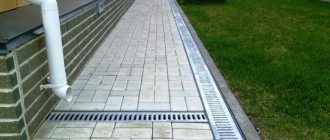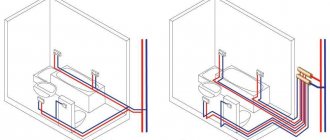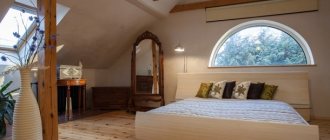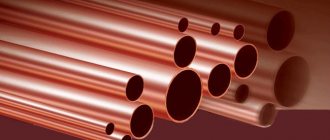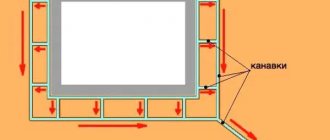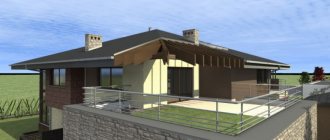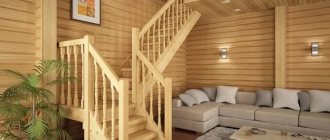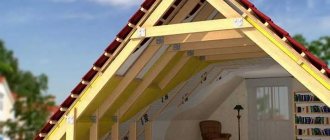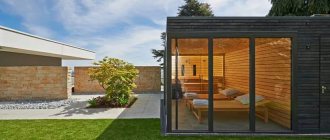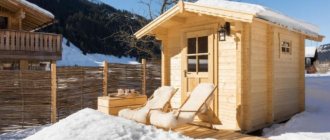Owners of dachas and country cottages have always strived to achieve the most approximate conditions for the comfort of being outside the city. And the main component in this case has always been the presence of a water supply at the dacha site. In this article we will tell you in what ways you can organize a country water supply today, what needs to be done for this, what instruments and devices can be used.
The simplest water supply in a country house is a pump and hose Source de.decorexpro.com
Water supply at the dacha
In the recent past, the main source of water at the dacha was a well or an artesian well, on which a rocking chair was placed. There was no talk of any water supply then; the supply of water for drinking and domestic needs was organized using buckets. This required some time and effort. That is, there was no talk of any comfort.
Buckets and watering cans were even used to water the vegetable garden and replenish water supplies in the summer shower. As an option, they used metal barrels and other containers that were filled with rainwater.
A rainwater barrel for watering green spaces Source journalexpress.ca
All this did not prevent people from living outside the city. But the quality of life was not at a high level. Everything changed when the first household pumps went on sale. These were submersible units operating from an alternating current network of 200 volts. Small in size, but with fairly good performance and pressure, the pumps immediately became popular. They were simply immersed, for example, in a well or pond, from where they used to carry water in buckets, plugged into an outlet, and received a powerful pressure of water pouring out of a hose.
Craftsmen immediately realized that pumps are an opportunity to change living in a dacha and increase the comfort of living. Therefore, they immediately began to develop and implement simple, and in some cases even very simple, water supply networks.
Water supply from a European barrel with rainwater Source kohlmaier.info
Simple plumbing
The simplest water supply network, also called summer water supply, is a pump connected to an extensive system of scattered hoses. The latter are scattered throughout the area so that with their help they reach water consumers. Usually this is the construction of the dacha itself, where a sink is connected in the kitchen; on the street there is a summer shower and a tap for watering green spaces. Three points for a summer residence are the optimal condition. In addition, submersible pumps were specially designed for this purpose. That is, they do not have such a large power to supply water to a large number of consumers.
This type of water supply network received the name “summer” only because it could only be used in the summer in warm weather. In the fall, the hoses were dismantled, freed from water, twisted, the pump was pulled out from the water intake source, and all this was stored in the shed until spring.
But the most interesting thing is that such a plumbing system was inexpensive for the owners of the dacha. In addition, it was always possible to change the location of the water supply sections by moving the hose from one place in the country to another. The hose trains were connected by sections of steel pipes, usually with a diameter of 15-32 mm. Fittings in the form of tees or crosses were made from the same pipes using electric welding.
Connecting hoses for irrigation with plastic fittings Source bouw.ru
Today, metal pipes have been replaced by plastic fittings, which are sold in hardware stores. And although this type of plumbing is used less and less in suburban areas, fittings are still purchased, which means that someone else still uses it.
It should be noted that the water supply network of a pump and hoses is divided into two groups according to the methods of laying the latter: open and closed. The first is hoses simply laid on the ground. They are in plain sight, and if the owner of the dacha has no complaints about the appearance of the water supply, then this option is acceptable.
The second is hoses that are laid in prepared grooves (trenches). They are of small depth - 10-15 cm. The laid hose distribution is covered with soil, so there are no problems with the appearance of the summer cottage.
Open garden plumbing system Source gizbar.com
There is another simple option in which plastic pipes are used instead of hoses. This is usually a closed system that is buried in the ground. The pipes are distributed throughout the site to the required consumers. From them you can assemble a collapsible system or a non-dismountable one.
- The first is small sections connected to each other by ruckers , they are also a connecting element called “ American ”. That is, at any time the water supply network can be dismantled and stored in the same shed.
- The second is a non-separable system . Therefore, it is planned in advance, creating a distribution scheme for consumers. It is done once and for all . Of course, it is not a problem for the master to remake the network, for example, by cutting into the pipe distribution another section to an additionally installed consumer.
Country water supply from plastic pipes Source aqua-rmnt.com
Complex country water supply systems
In fact, water supply in a dacha can be organized, as they say, using the latest technology. There are a huge variety of water pumps and filtration systems on the market today. All this is freely available for little money. That is, today organizing an autonomous water supply system that would supply a country house with the cleanest water is not a problem. Therefore, let's look at what manufacturers offer today instead of the simplest garden water supply systems.
As is the case with simple water supply systems, water intake outside the city is organized from a well or open reservoirs. Today, another source is used - wells that are drilled to a sufficiently great depth, where the purest water lies in large quantities.
Each source uses its own pumps, because in each of them water intake is carried out differently. And since pumping equipment is energy-dependent, that is, it runs on electric current, manufacturers make sure that water and current do not meet somewhere inside the pumping unit.
Diagram of a complex country water supply Source kapustik.ru
See also: Catalog of companies that specialize in the installation of water supply and sewerage.
Types of pumps used
In dachas, three types of pumping devices are used to organize an autonomous water supply:
- Superficial . They are installed next to the source of water intake, without lowering them into the water itself. Hence, in principle, the name. A hose or plastic flexible pipe is lowered into the water, at the end of which a mesh filter is installed. The second end is connected to the pump to the suction pipe. A water supply network is laid from the device itself, or rather from the supply pipe.
Surface pump for a summer residence Source tr.decorexpro.com
- Submersible . They have already been mentioned, we’ll just add that such pumps are used only if the water intake level is not lower than 8-10 m. They are partially or completely immersed in water, hence the name of the units.
- Boreholes , they are also deep . They were specially invented for pumping water from wells, that is, from great depths. At dachas, they use devices that can be used to lift water from a depth of 50 m. Although manufacturers also offer other models that submerge to depths of over 200 m.
Borehole pump for country water supply Source strhouse.ru
Features of a private water supply system
It is better if the planning of the water supply is carried out at the stage of drawing up the design of the summer cottage and house. A full-fledged project includes a number of drawings and documents, including:
- step-by-step work plan;
- layout diagrams of pipes and main elements of the water supply system;
- estimate, etc.
Plumbing diagram
To install a boiler and water meter unit, you need to allocate a small room on the first floor of the house. A room of 3-4 m2 will be sufficient. It is more convenient when the water input unit and the necessary technical devices are located in the same room - this gives the owner the opportunity to fully control the water supply process.
A typical private water supply system includes the following equipment:
- pipeline. Products made of polypropylene, metal-plastic and metal are suitable;
- set of taps and fittings;
Pipes and fittings - pump;
Surface pump for lifting water from a well - pressure gauge; Pressure gauge DM02 Meter
- expansion tank;
Expansion tank - pressure switch; Pressure switch RD-2R (Rosma)
- electrical support with full automatic protection;
- purification filters for removing suspended particles and various types of contaminants from the water;
Water purification filter - water heater. Installed as needed. In most cases, the cumulative model is more convenient.
Practical storage water heater for a summer residence
Plumbing diagram
And a few words about how to properly organize an autonomous water supply network at your dacha. First of all, the issue of the source of water supply is resolved. After which the pump is selected according to its installation type. That is, these two criteria are inextricably linked. And the second comes out of the first.
And now about the layout. If submersible or borehole models of pumping equipment are used in the water supply system, then surveying the location of the devices will not be necessary. As for surface aggregates, there are two options:
- The pump is located next to the water . For example, inside a well on a platform mounted above the surface of the water. Or inside a caisson, which is a sealed container installed in the ground above a borehole or well.
- The pumping unit is located inside the house . A pipe is led from it into a well or borehole. A special room is allocated for the pump. This could be a basement or a utility room. Here, all other elements of the autonomous system are usually installed near the pump: filters, electrical control panel, switchgear, storage tank, etc.
Layout of a surface pump in the basement of a house Source moikolodets.ru
Sometimes a special room is allocated for a surface pump, which is built on the street next to the cottage. It must be insulated.
As for the pipework, these are plastic pipes that are laid at a shallow depth, but must be insulated. Fortunately, you can find special thermal insulation materials for pipes on the market. Particular attention is paid to laying pipes inside the house. Typically, such a passage is planned at the stage of forming a country house project. Because the shorter the distance from the source of water intake to the cottage, the better: less material consumption, the pressure and productivity of the water supply does not decrease. Usually the installation inside the house is carried out either through the foundation of the building or through the wall.
Pipe selection
Plumbing in a country house is rarely made of metal pipes. They are heavy, quite expensive, and rust quickly. Assembling a water pipeline requires specific skills - welding, soldering. In addition, metal pipelines require special maintenance.
Plastic options are much easier to install and more convenient.
- HDPE – made of low-density polyethylene. Such products do not rot, do not rust, and do not burst when frozen, as they can stretch. The inner wall of the pipe is completely smooth, so it is practically impossible for such a water supply to become clogged. HDPE pipes are equally suitable for summer and year-round systems and last up to 50 years. Installation of the drainage system is simple - the pipes are connected and branched using fittings. For water supply, choose pipes with a blue line. They are distinguished by permissible pressure: 2.5 atm., 4 atm., from 10 and above.
- PVC is cheaper than HDPE and is joined using cold welding using glue. The seam and material can withstand pressure up to 12–16 atm. PVC is more sensitive to cold, but is also resistant to corrosion. The flexibility of the pipe is higher, so fittings are needed here only to connect individual branches.
- PPR - polypropylene pipes are rigid, but very durable. They are connected to couplings by soldering, which guarantees complete tightness and strength of the seams. They withstand severe frosts well and do not require insulation. The downside is expensive fittings.
HDPE
PVC
PPR
PVC pipes do not fit well with metal pipes and inlets. So it is better to choose HDPE for tying equipment.
Useful tips
And some recommendations from experts:
- Before purchasing pumping equipment, it is necessary to carry out calculations for consumers . That is, calculate the optimal ratio performance and total consumption .
- preliminary piping scheme , which takes into account all consumers , regardless of their seasonal or off-season use.
- It is necessary to correctly connect the pump to the power supply network . There are many nuances here, so a professional electrician .
- The owner of the dacha must first decide whether to buy all materials and equipment separately or purchase a ready-made pumping station . It cannot be said that one of the proposed options is better than the other. Therefore, it is better to consult with specialists who will study the features of the dacha and the source of water intake.
Drafting
Start by drawing up a system design. First of all, decide on the equipment. Specify the location of water intake points, calculate the required number of fittings, select the optimal material and type of water pipes.
Plastic pipes are used most often. These are durable and reliable products that fully cope with all the tasks assigned to them. At the same time, plastic pipes do not rust, which allows them to be sewn into walls, unlike their metal counterparts.
Draw up a detailed diagram of the future water supply system. Indicate all dimensions on the drawing. This way you can calculate the optimal footage and determine the required number of components. In this case, it is recommended to buy components with a 10-15 percent reserve.
You must also decide whether you will choose and buy all the necessary equipment yourself, or whether you will immediately buy a ready-made water intake station. At this point, be guided by your personal preferences.
Well
If the aquifer is deeper than 8-10 m, it is necessary to drill a well. It’s unlikely that you can do it yourself; you’ll have to hire someone. The pleasure is not cheap - drillers charge a lot of money for their work.
But, having spent money on a well once, you will provide your dacha with clean water in the required volumes. If you want to save money, you can try to negotiate with your neighbors and make a well for several summer cottages.
In this case, the water supply system requires a borehole or submersible pump. These devices are significantly more expensive than their surface counterparts, but in terms of efficiency in providing clean water, they are unmatched
Features of water supply for a dacha from a well
To assess the effectiveness of the system, it is necessary to draw a project; it is advisable to display all the rises and bends of the pipeline, the length of horizontal sections, and the laying of pipes in the house. The diagram should also indicate the location of all water-consuming devices (faucets, taps, showers, water heaters, etc.).
The next parameter that must be taken into account when choosing a pump is the maximum pressure that the pump can produce.
To calculate the required pressure for the system, you need to know the highest point of the water.
— Required pressure. When determining the required pump pressure, keep in mind that 1 meter of vertical pressure is approximately equal to 10 meters of horizontal pressure (there are actually many factors that affect this ratio). If the characteristics of the pump indicate that the maximum pressure at zero power reaches hmax = 30 meters, then this means that vertically this pump will lift water to a height of 30 meters or at zero height it will be able to deliver water approximately 300 meters horizontally (but the water will flow weak stream). For example, you install a pump in the basement of a house or garage located 4 meters below ground level. The water entrance to the one-story house where water is supplied is located 30 meters away. This means that you need a pump with a head of more than 6 meters.
— Maximum volume of water consumption. It is calculated as the sum of water consumption for all possible water points simultaneously. For example, watering the area, a shower in the house, a sink in the kitchen, a toilet on the second floor, etc. For example, with the simultaneous use of a shower, two taps in the sink, and a toilet flush system, the total water consumption will be approximately 1.9 m3/h (0.7+0.4+0.4+0.4=1.9).
Selecting a pump for lifting water
For a water supply system, a country water supply system, a pump is required. Vortex or centrifugal devices are used. The vortex pump is used for supply from shallow depths and is suitable for wells. It is worth knowing that such equipment operates warmly, but does not produce noise during operation.
Centrifugal units are quite noisy, but can deliver water from great depths and are insensitive to low temperatures. Such a pump can supply water from a depth of no more than 10 meters.
Submersible pumps are used for deep wells. They are immersed in a well, from which water is supplied through pipes to the surface. The maximum depth from which water can be taken is 40-45 meters. For a plot of 10 acres and a small two-story house, a pump with the following parameters will be optimal:
— Electric motor power ranges from 250 W to 1400 W.
— Productivity — 1500-4000 l/h.
— Tank capacity is 70-100 liters.
— Lifting height from 8 to 50 m.
When making your selection, keep in mind that the data sheet indicates maximum specifications that must be met under certain conditions. With deviations from them, the parameters can be significantly lower.
Water supply by pumping station
If the water level in the well consistently exceeds 7 meters, a pumping station may be the best solution. It already has everything necessary to ensure complete water supply:
- centrifugal pump;
— input filter;
— check valve;
- receiver
— automatic overload and dry running protection system
- pressure switch
The capabilities of pumping stations are more extensive; such a system can completely supply an entire house of several floors with water. Of course, first you need to make all the calculations both for the installation itself and for the pipelines. The diameters of the pipes must comply with the installation recommendations, both at the inlet, before and after the pump. As a rule, for private water supply you should choose pipes DN 25 mm, 32 mm or 40 mm.
The pumping station for direct water extraction from the well must be located in close proximity to the well. To do this, you should allocate a place, it can be a caisson (sealed structure, container), in which the equipment will be well protected from the possibility of flooding with groundwater, and also sufficiently insulated from low temperatures in winter.
Advantages
— Remote location (outside the house) without noise.
— Automatic system
— Everything you need is there, eliminating the need to install additional equipment, which increases reliability.
Flaws
— It is necessary to equip a caisson - additional costs.
Scheme with storage capacity
Capacity (tank) plus a pump or pumping station.
This organization of water supply to a country house allows you to create the necessary supply of water.
Storage tank, installed outside the house or in the basement
To supply water to the water supply system, a pumping station is connected to the tank - a surface pump with a hydraulic accumulator and a pressure sensor. When the pressure in the accumulator drops, the pump turns on and brings it to the desired value set by the user.
Note: The hydraulic accumulator of the pumping station compensates for pressure peaks when the pump is turned on/off and significantly reduces the frequency of such turns on and off.
How to calculate the volume of a water tank? The instructions are quite obvious: it is equal to the product of the daily flow rate and the maximum interval between turning on the water supply.
Tip: In general, household water consumption is calculated based on a norm of 200 liters per day per person. Let’s say if two people permanently live in a country house and water is delivered on schedule twice a week, then the storage capacity should be at least 1600 liters.
Calculation: 200 (consumption per person per day) x 2 (number of inhabitants) x 4 (interval between days of water supply) = 1600 liters.
Necessary equipment
To install a water pressure system at your dacha you will need:
- submersible well pump - its type and power depends on the depth of the well, the required volume of water and the nature of the system;
- HDPE pipes - usually 32 mm. Less commonly, a 40 mm pipe is required if the output is 1 ¼”;
- borehole head;
- fittings for joining pipes;
- cable with a moisture-proof sheath - for connecting the pump;
- heat-shrink sleeve for connecting the cable to the pump;
- stainless steel cable clamps;
- hot air gun or gas burner;
- filters - depending on the type of well and installation location;
- storage tank, if needed.
If other pipes are used - PVC, PPR - other connecting elements and special tools for soldering will be required.
Most pumps only work with clean water.
Concrete wells
In order to make a well from monolithic concrete, you must first dig a shaft. Then two formworks are installed in it: one along the walls of the shaft, the other at some distance from the first. Concrete is poured into the gap formed between the formworks. It must be left in the formwork until completely dry.
Cement is made using 400-grade Portland arch cement, sand, aggregate (gravel or crushed stone) and water. The ratio of parts should be as follows: 1: 2:3: 0.5.
First, cement must be mixed with sand in a mortar box, then you need to add water and use a shovel to mix everything thoroughly. The filler is moistened with water and added to the resulting solution.
Concrete is laid in layers of 15 cm and compacted until laitance appears. In order for the concrete to harden well, it is necessary to lay it for 7 days with damp sawdust or burlap, which must be moistened with water several times during the day.
Anti-freeze hydrants and taps Unipump WF series
In our online hypermarket you can choose a suitable size hydrant or anti-freeze watering tap produced by the Russian brand UNIPUMP WF series.
We present to your attention two of the most popular hydrant models:
Anti-freeze taps are represented by models of the WF series:
You can learn about the features and advantages of these models on the website page
SES requirements for water
In order for no one to pick on us, we need to know the water requirements.
After manufacturing and supplying water to the room, it is necessary to take samples and take them for testing:
- According to the platinum-cable scale, we should not have colorlessness of more than 30 percent;
- There should be no foreign odors or other colors;
- The percentage of nitrates should be no more than ten;
- There should not be more than 10 bacterial bacillus per liter of liquid.
Video description
This video shows the installation of pipes:
It consists of the following elements:
- The tank is designed to accumulate water, which will subsequently flow into the water supply system. It is positioned so that it is higher than the pipes through which water flows for irrigation, washing or other purposes.
- Water can simply flow out of the tank through the pipes under the influence of gravity. However, a pump can be additionally used to speed up its movement.
- A supply line must be installed for irrigation. Through it, water should flow from the tank to those pipes through which irrigation will be carried out.
- To water the garden, pipes with a large number of small holes lying on the ground can be used.
- For fruit trees, garden drip tape can be used.
- To connect to main pipes, special tees are used.
- When watering, it is convenient to fertilize the plants at the same time. To do this, provide a special container connected to pipes in which fertilizers are dissolved in water.
Summer water supply Source trubamaster.ru
Preparatory work
Country water supply includes an irrigation system and a building maintenance system. Therefore, when designing, you must immediately take into account how many water intake points there will be on the site, and how much water will be required for irrigation.
- Make a drawing . It indicates the location of the beds. It is preferable to place the connection point in the garden, since stretching long and heavy hoses is inconvenient.
- All water consumers are noted on the building drawing : sinks, toilets, showers, boilers. The diagram immediately marks the installation locations of the taps: after the branch in the house, on the site, before the branch.
- At the lowest point of the system, they plan to install a drain valve .
- Select the type of water supply. The summer system does not need to be deepened into the ground. Winter ones need to be buried below the freezing level of the soil and insulated. This needs to be planned in advance.
- After drawing up the drawing, calculate the required number of fittings , taking into account turns, and calculate the length of the pipeline.
Valera
The voice of the construction guru
Ask a Question
Since power outages are common at the dacha, it is recommended to install a storage tank. The latter can be used as a reservoir for storing water reserves and as a rain storage tank. For this purpose, you can use a special tank, a plastic barrel of sufficient volume.
Required Tools
To carry out work on arranging the water supply of a private home, you will need the following list of tools:
- shovel;
- adjustable and gas wrenches;
- welding machine for polypropylene pipes;
- roulette;
- pipe cutter;
- knife;
- hacksaw saw;
- silicone and sealant and a gun for them.
For electrical work you will need:
- screwdriver;
- tester;
- wire cutters and other electrician tools.
Since drilling a well yourself is highly not recommended, tools for performing this work are also not indicated on this list.
Procedure for replacing a water heater
In most cases, the boiler is replaced with an installation of the same volume as before, but even if you choose a more efficient model, there are no difficulties. Typically, all inlet and outlet pipes of a water heater are equipped with standard fittings for plumbing threads, and the distance between them is standardized, which makes it easy to make a rigid supply of water and gas. If you need to change the configuration of pipelines, you can reduce the amount of work by using high-quality flexible hoses in a metal braid.
Although there are many articles on the Internet that recommend replacing the boiler yourself, it is better to use the services of professional plumbers. Our employees will replace a water heater of any system with a similar one or a different brand (or type) in accordance with all the rules and guarantee the quality of all operations. When replacing a boiler, the following is done:
dismantling the old water heater;
